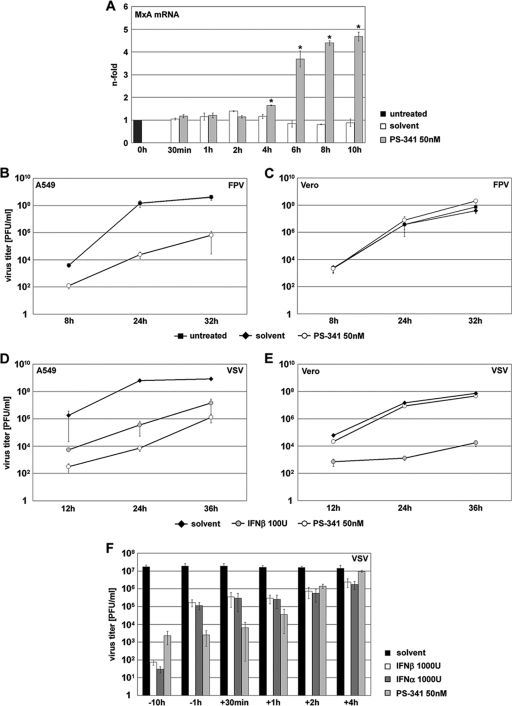FIG. 7.
PS-341 treatment induces type I IFN response genes, leading to suppression of virus propagation. (A) A549 cells were treated for the indicated times with 50 nM PS-341 or solvent. Then cells were lysed and RNA was subjected to reverse transcription. cDNA was analyzed by quantitative RT-PCR to determine amounts of transcripts of IFN-dependent MxA. Arrow bars represent standard deviations of two independent experiments and are generated as the fold change compared to the untreated control. *, P < 0.05 compared to untreated control. (B to E) A549 cells (B and D) or Vero cells (C and E) were pretreated for 1 h with 50 nM PS-341 (B to E), for 12 h with 100 U of IFN-β (only D and E), solvent, or left untreated. After that cells were infected with avian FPV at an MOI of 0.001 (B and C) or with VSV at an MOI of 0.001 (D) or 0.0001 (E). Subsequent to virus inoculation cells were posttreated with 50 nM PS-341 (B to E), 100 U of IFN-β (D and E only), solvent, or left untreated. After the indicated times p.i. supernatants were obtained and progeny virus titers were determined by standard plaque assay. Arrow bars represent standard deviations of three independent experiments (panel E shows results of one representative experiment out of four). (F) For time-of-addition kinetics analysis, A549 cells were either pretreated for 10 h or 1 h with 50 nM PS-341 or 1,000 U of IFN-β or IFN-α before infection and were additionally posttreated after infection or left untreated. Cells were infected with VSV at an MOI of 0.001. After virus inoculation cells were posttreated with 50 nM PS-341 or 1,000 U of IFN-β or IFN-α. The proteasome inhibitor or IFNs were added after virus inoculation (−10 h, −1 h, or +30 min) or they were added at different times p.i. as indicated (+1 h, +2 h, and +4 h; cells were not pretreated before infection). At 12 h p.i. supernatants were obtained and progeny virus titers were determined by standard plaque assay. Shown is one representative experiment out of three independent experiments.

